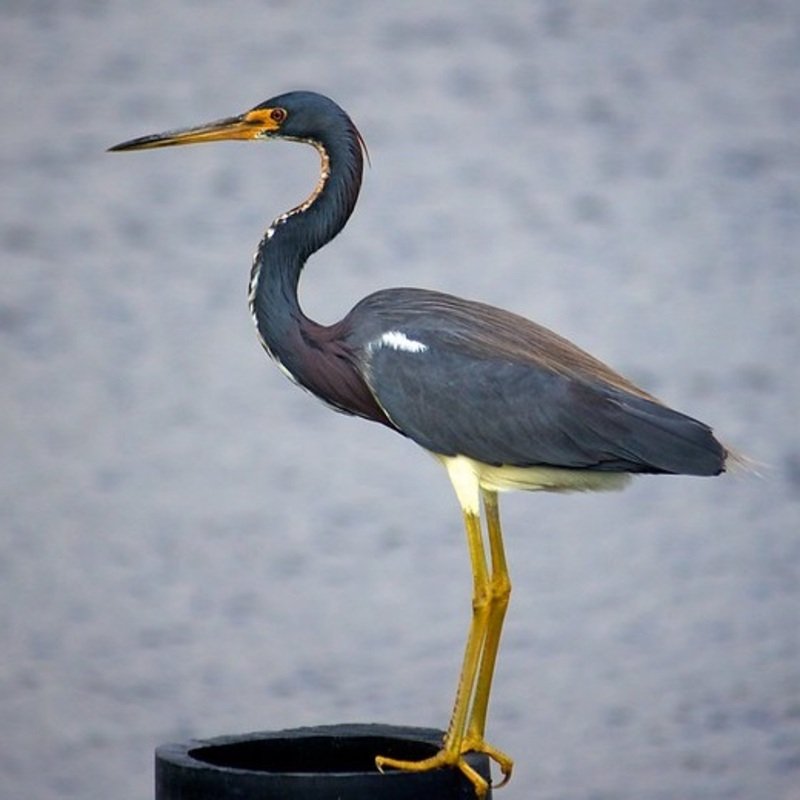The tricolored heron, Egretta tricolor, formerly known as the Louisiana Heron, is a small heron species native to the Americas’ coastal regions; in the Atlantic region, it ranges from the northeastern United States south along the coast, through the Gulf of Mexico and the Caribbean, to northern South America as far south as Brazil. It ranges from Peru to California in the Pacific region, but it is a nonbreeding visitor to the far north.
Quick Overview: Egretta Tricolor – Tricolored Heron
Body size: Around 24-26 in (61-66 cm) and a weight of 414 g (14.6 oz)
Main colors: White, Blue-gray, Rust-Brown, Olive-Brown
Range: Eastern United States
Migratory Bird: Yes
Best time of the year to see in the U.S.: March, April, May, September, October, November
Conservation Status: Least Concern
Tricolored heron Description
Blue-gray upperparts, head, neck, and wings; paler rump; white fore neck stripe; white belly. Additionally, during the breeding season, it has white plumes on the back of the head and rust-brown plumes on the lower neck and back. Olive-brown is the color of the bill and legs.

Size
These birds have a length of 24-26 in (61-66 cm) and a weight of 414 g (14.6 oz). Their wings could range from 36 in (91 cm).
Feeding
Tricolored herons hunt and catch animals in shallow water. The bird exhibits a variety of prey-catching activities. Hancock and Kushlan refer to their most common method of prey capture as a “walk-quickly-run-open wing tactile sequence”. The prey-catching behavior of Egretta tricolor varies according to the habitat in which they inhabit, however they find practically all of their food in shallow waters.
Habitat
The tricolored heron is described as a bird of shallow marshes and coastlines, frequenting mudflats, mangrove swamps, and bays”. They frequently like to reside in mangroves, freshwater wetlands, and on the edges of rivers. Exceptions to these habitat zones have been discovered; tricolored heron colonies have been discovered on dry land and at high altitudes.
Behavior
Migratory birds, Tricolored Herons are. Populations from North America have been observed to winter in Colombia and Ecuador” Egretta tricolor disperses “…into the south-central United States following the mating season.
Egretta Tricolor Scientific Classification
- Kingdom: Animalia
- Phylum: Chordata
- Subphylum: Chelicerata
- Class: Aves
- Order: Pelecaniformes
- Family: Ardeidae
- Genus: Egretta
- Species: Egretta tricolor
Other common names
Formally known as Louisiana Heron.
Best time of the year to see
In the United States, the best time of year to see these birds are during the Spring season (March-May) and during the Autumn season (September – November).
Distribution of the Tricolored heron in the USA
Breeds in southeastern New Mexico and Texas along the Gulf Coast, and north to southern Maine along the Atlantic coast. Winters along the Texas and New Jersey coasts, all the way south to northern South America and the West Indies.
The Tricolored heron can be found in the following states in the United States – Alabama, Alaska, Arkansas, Colorado, Connecticut, Delaware, Florida, Georgia, Hawaii, Illinois, Indiana, Kansas, Kentucky, Louisiana, Maryland, Massachusetts, Michigan, Mississippi, Missouri, New Hampshire, New York, North Carolina, Ohio, Oklahoma, Pennsylvania, Rhode Island, South Carolina, Tennessee, Vermont, Virginia, West Virginia, and Wisconsin.
